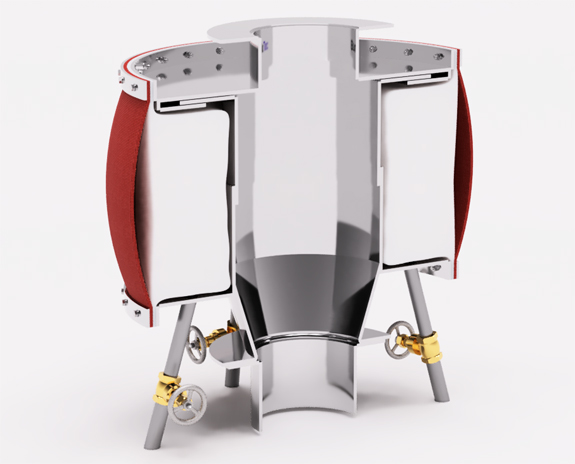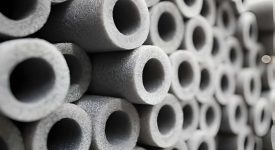Fabric expansion joints play a crucial role in industrial piping systems, acting as the unsung heroes that ensure smooth operations and efficiency. These flexible components are the key to absorbing thermal expansion, reducing vibrations, and compensating for misalignments, ultimately contributing to the longevity of the entire system.
Imagine a high-pressure industrial environment where temperatures fluctuate rapidly, and vibrations are a constant challenge. Fabric expansion joints act as shock absorbers, dampening the impact of these harsh conditions and ensuring that the system functions seamlessly without any hiccups.

One of the primary benefits of fabric expansion joints is their ability to reduce noise levels significantly. By absorbing vibrations and preventing them from propagating throughout the system, these joints create a quieter and more pleasant working environment for all involved.
You can examine the links below:
Moreover, fabric expansion joints are known for their corrosion resistance properties, which are essential in industrial settings where exposure to various chemicals and elements can lead to deterioration over time. By incorporating these joints into the system, operators can mitigate the risk of corrosion-related issues and extend the lifespan of the equipment.

Cost-effectiveness is another advantage offered by fabric expansion joints. Compared to traditional rigid connections, these flexible joints are more affordable to install and maintain, making them a practical choice for companies looking to optimize their operational costs without compromising on quality.
When it comes to installation and maintenance, following best practices is paramount to ensure the optimal performance of fabric expansion joints. Regular inspections, cleaning, and lubrication are essential tasks that can help prevent premature wear and tear, ultimately leading to a longer lifespan for the joints.

By understanding the importance of fabric expansion joints and incorporating them into industrial piping systems, companies can enhance efficiency, reduce downtime, and ultimately improve the overall productivity of their operations. These seemingly small components can make a significant difference in the performance and longevity of industrial systems, making them indispensable in the pursuit of operational excellence.
What Are Fabric Expansion Joints?
Fabric expansion joints are essential components used in industrial piping systems to ensure smooth operation and longevity. These joints are designed to absorb thermal expansion, reduce vibrations, and compensate for misalignments, ultimately enhancing system efficiency. By providing flexibility and adaptability, fabric expansion joints play a crucial role in maintaining the integrity of industrial processes.
Benefits of Fabric Expansion Joints
Fabric expansion joints offer a wide range of benefits that contribute to the efficiency and longevity of industrial piping systems. These advantages make them essential components in various industrial applications. Let’s explore some of the key benefits of fabric expansion joints:

- Noise Reduction: Fabric expansion joints help dampen noise and vibrations, improving the overall working environment in industrial settings.
- Corrosion Resistance: These joints are resistant to corrosion, extending the lifespan of the piping system and reducing the need for frequent replacements.
- Cost-Effectiveness: Fabric expansion joints are a cost-effective solution for managing thermal expansion and contraction, offering long-term savings for industrial operations.
- Easy Installation: Their flexible nature and lightweight design make fabric expansion joints easy to install, saving time and labor costs during system setup.
By providing noise reduction, corrosion resistance, cost-effectiveness, and easy installation, fabric expansion joints play a critical role in maintaining operational efficiency in industrial environments. These benefits not only enhance the performance of piping systems but also contribute to overall safety and productivity in industrial processes.
Types of Fabric Expansion Joints
Fabric expansion joints play a vital role in industrial piping systems, offering flexibility and durability to accommodate various operational needs. There are several types of fabric expansion joints available, each tailored to specific requirements to ensure optimal performance and longevity. Let’s delve into the different types of fabric expansion joints:

1. Single-Layer Fabric Expansion Joints:
- Designed with a single layer of fabric material, these joints are suitable for applications with moderate temperature variations and low pressure levels.
- They are cost-effective and easy to install, making them ideal for systems where flexibility is a key consideration.
2. Multi-Layer Fabric Expansion Joints:
- Consisting of multiple layers of fabric material, these joints offer enhanced durability and resistance to higher temperatures and pressures.
- They are commonly used in industrial settings where the operating conditions are more demanding and require a robust solution.
3. Composite Fabric Expansion Joints:
- Combining different materials such as fabrics, metals, and elastomers, composite joints provide a versatile solution for complex piping systems.
- They offer superior flexibility, corrosion resistance, and thermal stability, making them suitable for a wide range of industrial applications.
Each type of fabric expansion joint has its unique characteristics and benefits, catering to specific requirements in industrial environments. By selecting the right type of joint based on the operational needs and conditions, businesses can ensure efficient and reliable performance of their piping systems.
Installation and Maintenance Tips
When it comes to the installation and maintenance of fabric expansion joints, attention to detail is key to ensuring optimal performance and longevity. Here are some essential tips to consider:
- Proper Alignment: Ensure that the fabric expansion joint is correctly aligned with the piping system to prevent undue stress and premature wear.
- Secure Mounting: Securely fasten the expansion joint in place using appropriate mounting hardware to prevent movement and potential damage.
- Regular Inspections: Conduct routine inspections to check for any signs of wear, tear, or damage that may impact the joint’s functionality.
- Cleaning and Maintenance: Keep the expansion joint clean and free from debris to maintain its flexibility and prevent blockages.
- Temperature Monitoring: Monitor the temperature of the system to ensure that the expansion joint is operating within its specified temperature range.
Additionally, it is crucial to follow the manufacturer’s guidelines for installation and maintenance to avoid voiding warranties and compromising the performance of the fabric expansion joint. By adhering to these tips, you can maximize the efficiency and reliability of your industrial piping system, minimizing the risk of unexpected downtime and costly repairs.








